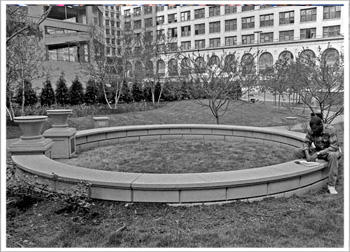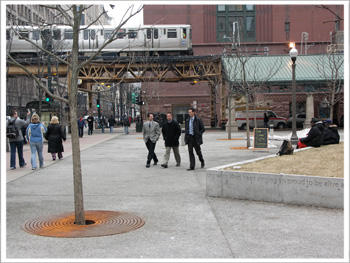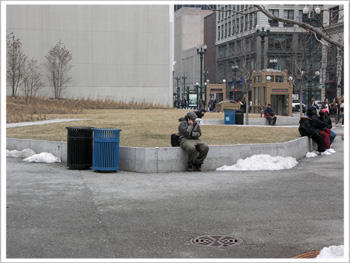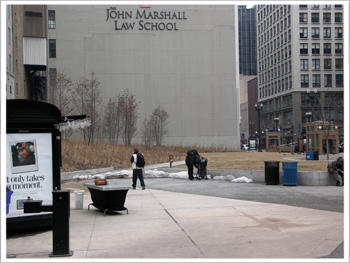By Jeff Huebner
Where Are the Anti-War People? Where Are Their Programs? Two Daleys, Two Wars, Two Pritzker Parks, Two Memorials
In November 1991, a new kind of park was dedicated at the northwest corner of State and Van Buren Streets in the Loop. It occupied the former site of the Rialto, the last SRO or single-room occupancy hotel downtown, which was demolished in fall 1990 after a fire, displacing 20 already luckless down-and-outers.
The hotel was replaced by an artwork, or rather a public-art space, designed by then-Yale University art professor Ronald Jones. Pritzker Park, as it was called (after socialite and Harold Washington Library Center patron Cindy Pritzker), was a project of the nonprofit Sculpture Chicago and the city’s Department of Planning. The visual centerpiece of this “site for the play of the imagination and a haven of green space in the urban environment,” as the plaque put it, was a three-dimensional re-creation of a grove of 13 linden trees and a black granite wall with urns modeled after Rene Magritte’s surrealist painting The Banquet. (It hangs at the Art Institute of Chicago.)
The “oddly different downtown retreat” (according to the Chicago Sun-Times) had other quirky features, most notably its council rings – or circular benches – and plantings in the Prairie style of Jens Jensen, the renowned Chicago landscape architect. One of the rings was also a sandbox for children, and inside was inscribed a quote from 19th-century American poet Henry Abbey, “What do we plant?” It was supposed to remind us that caring for the environment was a personal responsibility.
But that’s not all it was supposed to remind us. As Jones told me in an article for the June 18, 1992 issue of New City, the quote was also meant to echo a phrase that Mayor Richard J. Daley used to mock his critics, including Vietnam War protesters, during the 1968 Democratic National Convention: “These people who come here from other places and cause trouble – Where are their programs? What trees do they plant?”
(What Trees Do They Plant? was also the title of an hour-long documentary produced by the Chicago Police Department to counteract ’68 “police riot” accusations, and focused on the alleged violent intentions of the protesters and their international communist ties. This “Special Report on the Chicago Riots” aired on 140 TV stations across the nation barely two weeks after the end of the convention.)
The Pritzker Park sandbox with the Daley (or Daley-like) quote is the closest the late mayor has come to being (dis)honored with a back-handed monument. Other attempts to honor Hizzoner with a public memorial never got off the ground. In 1977, a year after his death, there had been a half-serious campaign to replace the Picasso in Civic Center Plaza (now Daley Plaza) with a Daley sculpture. “Displacing [the Picasso] would stamp Chicagoans – who already have an image problem abroad – as barbarous ingrates,” editorialized the Chicago Daily News (May 13, 1977).
A year later, the Chicago art community hooted when it was announced that a $500,000 commission to create a Daley memorial would be awarded to either Frenchman Jean Dubuffet or the Italian Giacomo Manzu (an avowed communist). “I can’t believe he’d want his monument done by a non-Chicagoan,” N.A.M.E. Gallery director Jerry Saltz told the Chicago Tribune (Feb. 1, 1978). “The mayor didn’t have much of that second city complex.” The commission never happened, although in 1978 Saltz – now New York magazine art critic – curated an exhibit at N.A.M.E. called “Daley’s Tomb,” in which 45 artists displayed designs for an imagined funerary monument.
Times – and Pritzker Park, and the Daleys – change.
Back in 1991, the city didn’t really know how long Pritzker Park would last. According to a Sculpture Chicago press release, “the park is intended to grace its South Loop site for several years until future redevelopments are in place.” But as artist Ronald Jones, now professor of interdisciplinary studies at Konstfack University College of Arts in Stockholm, told me 18 years ago: “It’s the best thing I’ve ever done, and I doubt it’ll ever disappear. Once the park is used and becomes popular, it’ll be hard to do away with.” Eva Olson, executive director of Sculpture Chicago, added: “The council rings look like they’ve been there for a hundred years, and hopefully they’ll be there for a hundred years more. It has the appearance of permanence.”
Pritzker Park 1.0 was destroyed in spring 2000. It had, ironically, become a haven for the homeless – perhaps some of the same folks who’d been kicked out of the old Rialto. The “What Do We Plant?” sandbox had become a urinal. (Daley: “Whose pot do they piss in?”) Perhaps the public never quite felt invited there, unsure if they should walk through a real-life surrealist painting. Soon, it became a wrought-iron-fenced grassy lot, with a row of trees along Van Buren. Plans were to make the space amenable to college students, with the new DePaul Center-Loop campus across the street and burgeoning university housing in the area. The park’s elements had been hauled away and dumped – er, stored – in a weedy South Side field, chronicled by the Reader’s Ben Joravsky a decade ago.
The city transferred ownership of the L-shaped parcel to the Park District in 2008, which worked with HoerrSchaudt landscape architects to redesign the space. It opened last spring. Concrete edgings along planted areas are engraved with quotes from writers, poets, and philosophers, mostly involving Chicago and the pursuit of knowledge (“It is brave to be involved” – Gwendolyn Brooks), selected by library patrons. If you had been there in early June you would’ve seen some misspellings: “Gandhi” was “Ghandi” and “Cisneros” was “Cisenos” – all the more embarrassing because her novel The House on Mango Street had just been selected for the One Book, One Chicago program. (The gaffes have since been fixed.)
The park has been criticized for having more concrete than landscaping, in order to accommodate a JCDecaux concession stand (already there) as well as a cafe with “moveable seating” (presumably coming), according to architecture writer Lynn Becker.
This is commercial space, meant to enhance revenue. (This is Chicago.) But here’s the thing: Why not make this half-plaza a permanent free-speech zone, in honor of current mayor Richard M. Daley? What got me thinking of this was Daley’s speech at the Chicago Neighborhood Development Awards on February 9 – seven years after his cops illegally detained and arrested more than 800 marchers on Michigan Avenue at the outset of the March 2003 invasion of Iraq.
He said, “What is it about America? How did we start this century with 10 years of war? Ten years of war! Where are the anti-war people? I look down at the Dirksen Center. Where are they? They’ve disappeared! What happened? I thought war was evil. Where are the people who believed in their heart against George Bush? What happened? But don’t you know it’s a political issue? We won the election. Now we go home.”
Those old Pritzker Park council rings, including the sandbox, dumped near the public-art warehouse beneath Roosevelt Road and Clark Street were supposed to have been reused elsewhere, like in new schools. (If anyone has seen them, please let me know.) No problem. I say we make a couple new ones, plant them in the park (“immoveable seating”), and then inscribe them with selections from Daley’s heartfelt rant. That way, we get a couple things in one: We get some political art (the dearth of which is mystifying to some local art observers, including me), provoking discussion. We also get something of a semi-permanent memorial to Daley’s legacy – unless an artist wants to sculpt a tribute to him in the form of an over-sized expired parking meter.
I can just see the words around the outside of the rings now: WHERE ARE THE ANTI-WAR PEOPLE? . . . I THOUGHT WAR WAS EVIL . . . NOW WE GO HOME. Would this be possible? Well, to quote the inscribed words of Lewis Carroll that appear in Pritzker Park: “Why, sometimes I’ve believed as many as six impossible things before breakfast.”
–
1. Pritzker Park 1.0. (Photo by Nathan Mendell, 1992. All others by Marjorie Woodruff.)

*
2. Pritzker Park 2.0. More concrete than landscaping?

*
3. “It is brave to be involved.”

*
4. What revenue does JCDecaux raise?

*
5. If you look closely, you can see the original misspelling of Gandhi’s name.

*
6. Why not a free-speech zone?

–
Comments welcome.
–
Also by Jeff Huebner:
* The Broom of Wicker Park
* Extensive and insightful comment on Goodbye, American Gothic People
Posted on March 22, 2010


